Planning a visit to Battle Abbey and battlefield in East Sussex? The site of the historic 1066 Battle of Hastings makes for a brilliant day out. Walk the battlefield, explore the Abbey ruins and take in the views of Battle High Street and countryside from the roof of the imposing gatehouse.

Battle Abbey, built by William I, looms large at the end of Battle High Street, my home town. Our charming market town in East Sussex is named after the conflict that took place on the site over 950 years ago.
Step inside the hefty wooden doors of the Great Gatehouse and you’ll walk the land where two armies fought and where the course of English history changed forever.
But before we do that, let’s get something straight. The 1066 Battle of Hastings didn’t take place in Hastings. It took place almost 8-miles inland in the heart of the countryside on Senlac Hill, in Battle, East Sussex.
How it all started in 1066
The Duke of Normandy and his army sailed from St Valery sur Somme, Battle’s twin town, in France. After landing at Pevensey the Normans marched inland to the battle site.
Meanwhile, the English Saxon army led by King Harold marched from Stamford Bridge in the north of England. On 14 October 1066, the two sides collided and fought for the future of England on Senlac Hill.
The Anglo Saxons were defeated and the Norman conquest of England began, making this one of the most important battles in English history.
In 1070 Pope Alexander II ordered William I to do penance for the bloodshed caused by the battle. He chose to build an abbey with the high altar on the spot where King Harold was felled by an arrow to the eye.
As with many abbeys in England, much was destroyed in the sixteenth century during Henry VIII’s Dissolution of the Monasteries. However, much remains of the impressive Battle Abbey and a day trip to Battle in East Sussex is a must-do during a visit to South East England.
Today I’m bringing you my guide, as a resident of the town, to visiting Battle Abbey. You’ll also discover a few other related things to do in Battle, East Sussex.

English Heritage
Battle Abbey is run by English Heritage and you’ll need to pre-book before you visit. It’s worth buying an annual membership which will save you money if you visit more than 2-3 of their larger sites during your year’s membership.
The route below is how I like to visit Battle Abbey but you may prefer to do this in reverse or make your own way round. The weather may also influence how you visit.
Looking for somewhere to stay in Battle? Check rates and availability here.
Explore the Abbey Gatehouse
The gatehouse of Battle Abbey is the dominating feature of Battle High Street. Enter through the gates and you’ll see The Abbot’s Great Hall ahead of you. This is now part of Battle Abbey School.
Turn right and enter a small doorway and explore inside the great gatehouse. Climb the spiral, stone staircase stopping off at each of the gatehouse floors. On each level you’ll find exhibitions and displays of artefacts. Many have been excavated from the abbey grounds and give an insight into Medieval life at the abbey.

Exhibition in Battle Abbey, East Sussex
The best views of Battle High Street

View of Battle high street from the Abbey
When you reach the top of the Great Gatehouse you’re rewarded with fabulous panoramic views. You’ll see Battle high street from above, parts of the battlefield, Abbot’s Hall and the countryside beyond. This is one of the best things to do in Battle and I make sure I make the climb to the gatehouse roof for the views at least once a year.
Battle Abbey Visitor Centre
On emerging from the gatehouse turn right and follow the path to the Visitor Centre. You’ll pass a rustic children’s playground, on your left, carved by a local artist, Keith Pettit. The playground is designed to fit in with the Medieval surroundings.

Step inside the Visitor Centre where you’ll find a fascinating exhibition on the 1066 Battle of Hastings complemented by interactive displays and a film which shows what happened on 14 October 1066 and the events leading up to it.
Pick up an audio-guide and continue past the centre onto the trail that leads around the battlefield. The audio-guide is well worth listening to and gives an account of the battle and points of interest around the site.
Walk the 1066 Battlefield

The 1066 Battlefield with Battle Abbey School in the background
Walking around the battlefield is a must-do on your visit to Battle. You’ll walk in the footsteps of the Saxons who fought for England and tread the land where the course of English history changed, almost one thousand years ago.
Sheep graze and wildflowers grow and it’s hard to imagine that this peaceful scene was once the setting for a day of so much bloodshed.
Along the battlefield route, you’ll find information boards that detail the progression of the 1066 Battle of Hastings and tie in with the audio-guide. The pathway is gravelled and fairly level.

A soldier and his horse
Wooden sculptures guard the pathway, again carved by Keith Pettit, representing both the Anglo-Saxons and Norman soldiers. You’ll also pass a picturesque lake and views of the battlefield with the backdrop of the abbey ruins.

Lake at Battle Abbey
The full battlefield circuit takes around an hour to walk although there is a shorter accessible route of around 15-20 minutes. This may also be a good option in bad weather.
Looking for somewhere to stay in Battle? Check rates and availability here.
The 1066 Battle of Hastings Re-enactment
If you visit Battle Abbey on the weekend nearest to 14 October, the battle is recreated on this field. We can often hear the battle cries from our garden and it’s not uncommon that weekend to see Normans queuing up in the fish and chip shop or Saxons buying a pint in one of Battle’s pubs.
If you wish to visit for the 1066 re-enactment you’ll need to book well in advance and extra fees apply. The 1066 re-enactment is a great weekend to visit Battle and soak up the atmosphere and the history in a dynamic way.
Visit Battle Abbey
As your walk around the battlefield comes to end you’ll approach the back of Battle Abbey. Exploring the Abbey is one of the best things to do in Battle. The first part you’ll see is the undercroft.

The back of the dormitory at Battle Abbey
Next, continue along the trail and wander through the peaceful walled garden accessed by a gate on your right. Historic varieties of apple and pear trees are interspersed with meadow flowers and beehives. Espalier trees cling to the red brick walls.
>>> Looking for somewhere to stay in Battle? Check rates and availability here.
The Dairy and the Icehouse
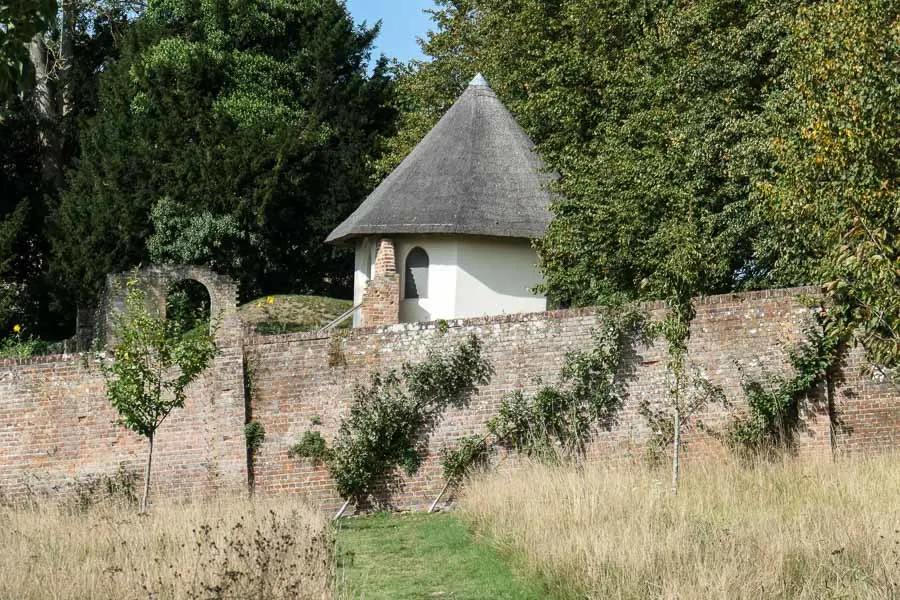
Battle Abbey Dairy from the walled garden
As you exit through the top of the walled garden you’ll spot the conical thatched roof of the pretty little Gothic-styled dairy.
Next to it is the icehouse, a small underground, grass-topped room which resembles a hobbit house. Ice would have been collected from the nearby lake and stored inside the brick-lined cellar for use in the dairy after the winter. Built around 1810-1820 both were restored in 1991 and are quite unusual to see.
The Dormitory
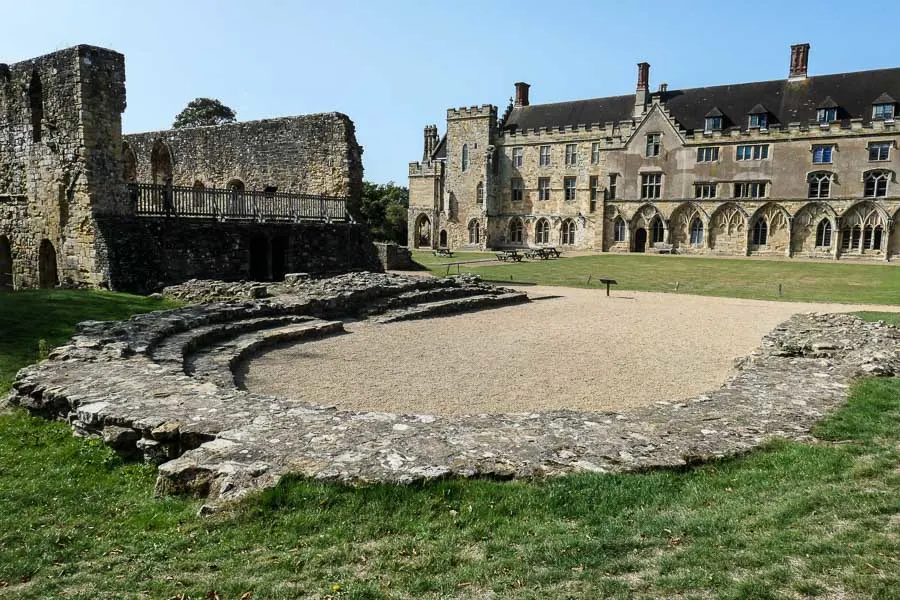
Battle Abbey with the dormitory left and Abbot’s hall ahead
Although parts of the Abbey, including the church, were destroyed in 1538 during the Dissolution of the Monasteries, there’s a lot to see around the grounds. What remains of Battle Abbey ruins are interesting to explore.
Climb the stairs to the dormitory rooftop for an overview of the grounds. Looking down you can easily see and how the site was originally laid out.
Next, head to the ruined dormitory range. Underneath you’ll find the Novices’ Chamber and Common Room with beautifully vaulted stone arches and ivy creeping in through the open windows. It’s very atmospheric.

Vaulted Ceilings in novices chamber, Battle Abbey
>>> Looking for somewhere to stay in Battle? Check rates and availability.
The Abbey Church
The church layout can clearly be seen from the dormitory roof with a good view of the layout. The location of the high altar is said to have marked the spot where King Harold met his end on the battlefield and a small memorial stone marks the spot.
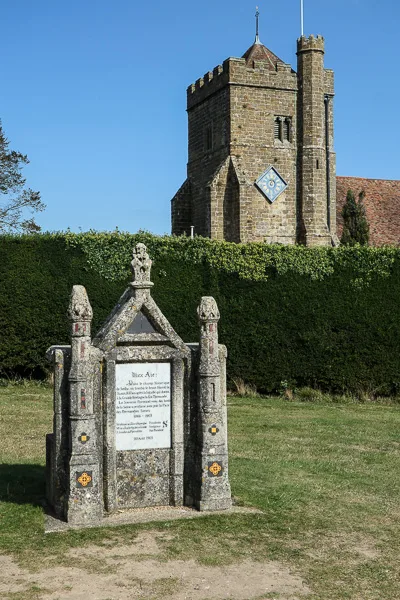
Beyond it are the remains of the thirteenth-century crypt where areas of low stonework are still intact.

Remains of the crypt at Battle Abbey
>>> Looking for somewhere to stay in Battle? Check rates and availability here.
The Abbot’s Great Hall
The Abbot’s Great Hall and cloisters are beautiful and much of it survived Henry VIII’s attempts at destruction in 1538. Abbot’s House is now part of Battle Abbey School and can only be accessed during a tour. These are held in August whilst the school is closed. However, the exterior of the Hall is impressive with some beautiful detail.

The Abbot’s Great Hall, Battle Abbey
The Abbey Walls
Finish your tour by climbing the steps to the abbey walls and take a walk along them for a view up Battle High Street. You’ll descend into a small area selling plants before heading to the back of the gatehouse where you can have a cuppa and a snack in the cafe before leaving through the gift shop.
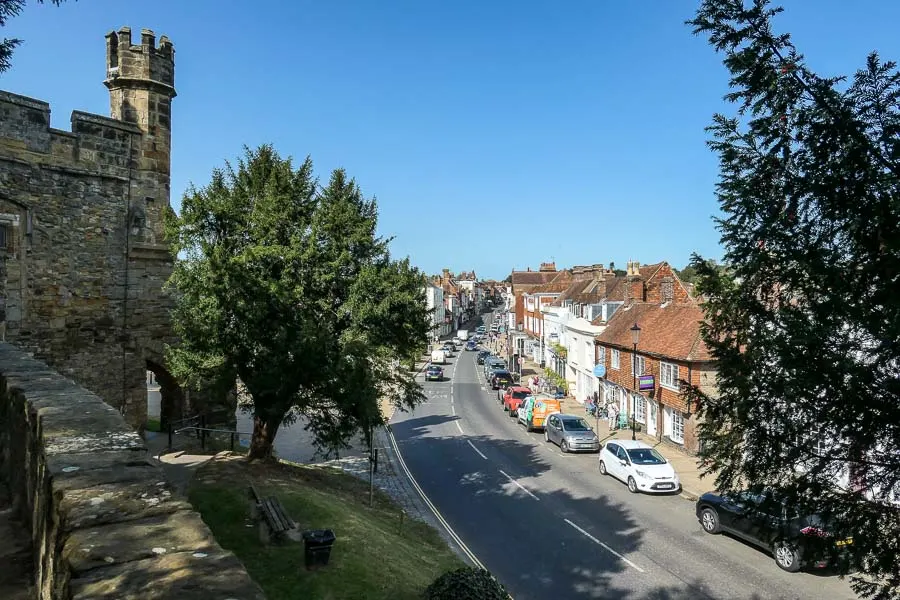
Walking the walls at Battle Abbey
Battle High Street
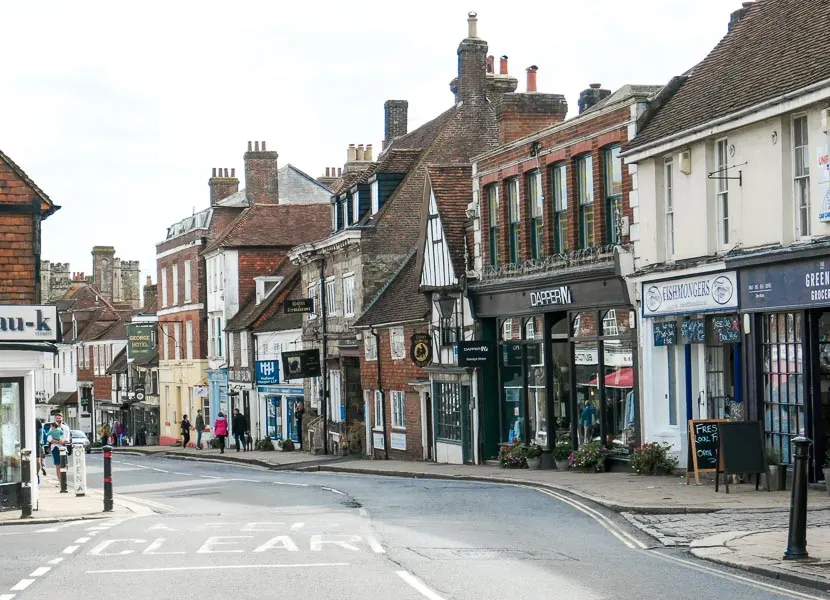
Battle High Street
Before you leave be sure to take a stroll up Battle High Street. As you walk by old architecture and half-timbered houses you’ll pass some lovely independent shops. They sell everything from clothes, homeware and plants to coffee, cakes and gifts. Check out how to spend a day in Battle after you’ve visited the Abbey.
The Almonry in Battle High Street
At the top of the High Street, on the left, you’ll find the Almonry, an old hall house built back in the fifteenth century. The Almonry houses Battle Museum of Local History with exhibits from preserved dinosaur footprints to ancient Roman artefacts, an axe from the 1066 battle and various town memorabilia.
The museum also tells about Battle’s past gunpowder industry and displays a Guy Fawkes effigy. The wooden head is said to be over 300 years old and is displayed each year atop a Guy Fawkes body for the town’s bonfire celebrations.
There’s more to see and do in Battle but Battle Abbey and the 1066 Battle of Hastings are the main attractions. Check back for an upcoming post about what else there is to see and do in the town.
>>> Looking for somewhere to stay in Battle? Check rates and availability here.
Battle Abbey Illuminated

In early December each year there’s a week when the Abbey is lit up in a festive illuminated trail. History and Christmas entwine in a magical trail of lights, unique installations, and effects. Check the English Heritage website for more details.
If you’re looking for festive events in Sussex check our post about the county’s best Christmas light trails.
Visiting Information
Battle Abbey, Butter Cross, High St, Battle TN33 0AE
Tel: 0370 333 1181
Battle Abbey opening times
Summer open daily 10:00 hrs – 18:00 hrs
Please note that during the winter months the abbey is only open at weekends. Times also vary throughout the year so please check the website opening times.
Battle Abbey admission fees
- Adults from £13.60
- Child (5-17 years) from £8.20
- Students / over 65s from £12.20
- Family (2 adults, up to 3 children) from £35.40
- Family (1 adult, up to 3 children) from £21.80
How to get to Battle by train from London
You can catch a direct train from London Charing Cross, Waterloo or London Bridge which takes around 1 hour 20 minutes. It’s then a ten-minute walk from Battle station up to the Abbey and Battle High Street.
Parking at Battle Abbey
Drive past the Gatehouse of the Abbey and head straight on to find the pay and display car park to the left.
There’s a charge for non-members or free for English Heritage members displaying their membership badge although you’ll need to enter your car registration in the ticket machine.
Places to visit near to Battle Abbey

Mermaid Street, Rye
If you’re thinking of spending a day or two in Battle then Hastings, Rye, Bodiam Castle and Herstmonceux Castle are all within a 30-minute drive. Hastings and Rye are also reachable by train.
Looking for somewhere to stay in Battle? Check rates and availability here.
Pin it for later…



Suzanne Jones is owner and editor at Hello Sussex which was founded in 2017. When she’s not exploring Sussex or writing about it you’ll most likely find her, camera in hand, enjoying coastal and countryside hikes across the county.
Suzanne is also travel writer and content creator at top travel blog The Travelbunny which she founded in 2011.



Kathryn Burrington
Thursday 8th of July 2021
I had no idea there was so much to see there and what a fabulous playground! Such a good idea.
Suzanne Jones
Thursday 8th of July 2021
You could easily fill 4-5 hours exploring the Abbey and grounds. I particularly like the giant wooden hampster wheel in the playground!